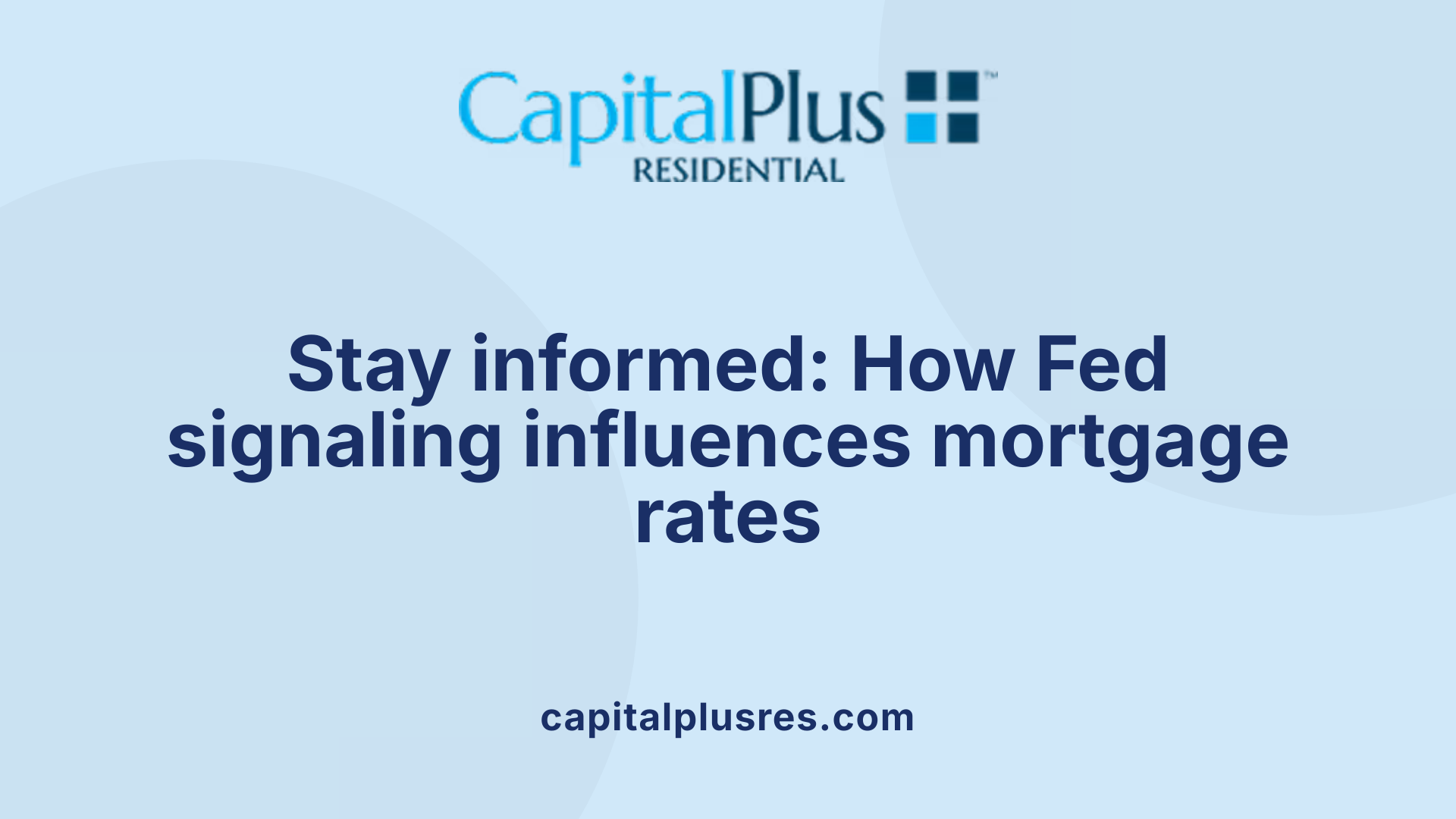Understanding the Federal Reserve's Influence on Home Loans
Mortgage rates significantly impact home affordability and purchasing power. While many buyers watch headlines about mortgage interest rates, fewer understand how the Federal Reserve (the Fed) indirectly shapes these rates through its monetary policy. This article explores the complex relationship between the Fed's actions and mortgage rate movements, helping borrowers and real estate professionals navigate the lending landscape with greater insight.
The Federal Reserve’s Monetary Policy and Its Tools
What is the Federal funds rate and how does it work?
The Federal funds rate is the interest rate at which banks lend reserve balances to each other overnight. It acts as the benchmark for many other interest rates, including those on short-term loans and adjustable-rate mortgages. By influencing this rate, the Federal Reserve indirectly affects borrowing costs across the economy.
What monetary policy tools does the Federal Reserve use?
The Federal Reserve employs several key tools to manage monetary policy and influence the federal funds rate:
- Open Market Operations (OMO): Buying or selling government securities in the open market to adjust the supply of money and credit.
- Discount Window Rate: The interest rate at which banks can borrow short-term funds directly from the Federal Reserve.
- Interest on Reserve Balances (IORB): Interest paid on excess reserves that banks hold at the Fed, which helps set a floor for the federal funds rate.
These tools work together to control liquidity and credit availability in the banking system.
How does Interest on Reserve Balances influence rates?
By paying interest on reserves, the Fed provides banks with an incentive to hold excess reserves rather than lending them out at lower rates. This mechanism helps maintain the federal funds rate within the Fed's target range, stabilizing short-term interest rates.
What role does the Discount Window play?
The discount window offers banks short-term loans to meet liquidity needs. The discount rate is typically set above the federal funds rate, discouraging excessive borrowing but providing a safety net that influences overall credit conditions.
How do Open Market Operations affect monetary policy?
Through open market operations, the Fed buys or sells U.S. Treasury securities and mortgage-backed securities to increase or decrease the money supply. Buying securities injects liquidity and tends to lower interest rates, while selling securities withdraws liquidity and tends to raise interest rates. These actions are central to guiding the federal funds rate and overall financial conditions.
Together, these tools shape the availability and cost of credit, including mortgage and loan rates, by controlling the baseline federal funds rate and influencing banks' borrowing costs.
Federal Funds Rate: The Starting Point for Borrowing Costs

What is the Federal Funds Rate?
The federal funds rate is the interest rate at which banks and credit institutions lend reserves to each other overnight. It is set by the Federal Reserve's Federal Open Market Committee (FOMC) as a target rate range. This rate serves as the benchmark for short-term interest rates across the U.S. financial system.
How Does It Influence Bank Borrowing Costs?
When the Federal Reserve adjusts the federal funds rate, it directly affects the cost banks pay to borrow money. An increase in this rate means banks borrow at higher costs, which typically leads to higher lending rates for consumers, including mortgages and other loans.
Connection to Short-Term Interest Rates
Because the federal funds rate governs overnight loans between banks, it establishes the floor for other short-term interest rates. These include rates on various credit products, such as credit cards, home equity lines of credit (HELOCs), and adjustable-rate mortgages, which often are tied closely to short-term indexes influenced by the Fed's rate.
Setting the Target Rate Range
The Federal Reserve does not set the federal funds rate directly but instead sets a target range. It then uses tools like open market operations, interest on reserve balances (IORB), and the discount window rate to influence the market rate toward this target. The success of these policies impacts borrowing costs throughout the economy, shaping overall credit conditions.
In summary, the federal funds rate is a critical starting point for borrowing costs in the United States. By controlling this rate within a target range, the Federal Reserve influences short-term interest rates and the broader availability and cost of credit.
Mortgage Rates and Their Link to the 10-Year Treasury Yield

How Do 10-Year Treasury Bond Yields Influence Fixed-Rate Mortgages?
Fixed-rate mortgage rates are closely tied to the yields on 10-year U.S. Treasury bonds. These Treasury yields reflect investor expectations about economic growth, inflation, and future interest rates, making them a key benchmark for long-term loan rates.
Historical Correlation Between 10-Year Treasury Yields and Mortgage Rates
Historically, mortgage rates have moved in tandem with 10-year Treasury yields. Data since the 1970s shows a consistent relationship where fixed mortgage interest rates track the movements of these Treasury yields, differing typically by a spread of 1.5 to 2 percentage points.
Understanding the Primary-Secondary Mortgage Spread
The difference between the 10-year Treasury yield and the mortgage rate is due to the primary-secondary mortgage spread, which accounts for lender costs, credit risk, and market dynamics. Before 2005, this spread averaged around 0.5 percentage points but has grown since the 2008 financial crisis due to increased costs and risk premiums.
What Does This Mean for Borrowers?
When Treasury yields rise, fixed mortgage rates generally increase as well, making borrowing more expensive. Conversely, decreases in Treasury yields tend to push mortgage rates down, impacting affordability and home buying activity.
| Factor | Description | Impact on Mortgage Rates |
|---|---|---|
| 10-Year Treasury Yield | Reflects market expectations for inflation and growth | Directly influences fixed mortgage rates |
| Fixed-Rate Mortgage | Long-term loan with rate tied to Treasury yield | Rates move closely with Treasury yield plus a spread |
| Primary-Secondary Mortgage Spread | Includes lender margins and credit risks | Causes mortgage rates to be higher than Treasury yields |
| Historical Correlation | Consistent tracking since 1970s | Confirms 10-year Treasury as a reliable benchmark |
This relationship underscores why monitoring Treasury bond yields is essential for understanding trends in fixed mortgage rates and making informed borrowing decisions.
Why Mortgage Rates Don't Mirror Federal Funds Rate Exactly

How Does the Federal Reserve Influence Mortgage Rates?
The Federal Reserve affects mortgage rates primarily through its control of the federal funds rate, which impacts short-term interest rates and the broader cost of borrowing for banks. However, mortgage rates do not change in direct lockstep with the Fed's rate because mortgages are long-term loans, and their rates are linked to different market dynamics.
Why Are Mortgage Rates Linked More to Long-Term Interest Rates?
Mortgage interest rates, especially for fixed-rate loans, tend to follow the yields on 10-year U.S. Treasury notes rather than the short-term federal funds rate set by the Fed. This is because the 10-year Treasury yield reflects investor expectations for long-term economic growth, inflation, and interest rates—all critical factors in pricing long-term loans like mortgages.
What Role Do Market Expectations Play?
Market expectations for the economy and future Federal Reserve policies heavily influence mortgage rates. Sometimes, statements or signals from Fed officials impact mortgage rates more significantly than the actual changes in the federal funds rate. This is because lenders and investors price in anticipated conditions well before they occur.
How Does the Secondary Mortgage Market Affect Rates?
Mortgage rates also depend on investor appetite for mortgage-backed securities (MBS) in the secondary market. When the Fed engages in asset purchases like quantitative easing, buying MBS lowers mortgage rates by increasing demand and reducing spreads. Conversely, reducing MBS holdings or tightening monetary policy can increase mortgage rates by raising the risk premium lenders demand.
This interplay means that while the Federal Reserve sets short-term rates, mortgage rates move according to a complex mix of factors beyond Fed policy alone, explaining why they don't mirror the federal funds rate exactly.
Fed Rate Changes and Their Immediate and Longer-Term Effects on Mortgages
How Do Rate Cuts and Hikes Affect Mortgage Rates?
When the Federal Reserve changes the federal funds rate, it influences borrowing costs across the economy, including mortgage rates. Typically, a rate cut by the Fed is intended to stimulate borrowing by making loans cheaper, which can lead to lower mortgage rates. Conversely, rate hikes aim to slow economic activity and combat inflation, often causing mortgage rates to rise. However, this relationship is not always immediate or direct, especially for long-term fixed mortgages.
What Is Anticipatory Lender Behavior?
Lenders often adjust mortgage offers in anticipation of Federal Reserve moves. Before a formally announced rate cut, lenders might lower mortgage interest rates expecting cheaper funding costs ahead. This proactive adjustment reflects the market’s forward-looking nature, where mortgage rates respond in advance to potential Fed actions rather than react solely after announcements.
How Does Market Signaling Influence Mortgage Rates?
The Federal Reserve’s statements and signaling about future policy shifts can have a significant impact on mortgage rates. Sometimes, these signals cause stronger market reactions than the actual Fed rate change. Investors adjust their expectations for economic growth, inflation, and credit risk, influencing bond yields and mortgage-backed securities, which directly affect mortgage rates.
How Are Adjustable-Rate Mortgages Impacted?
Adjustable-rate mortgages (ARMs) are typically tied to short-term indices like the Secured Overnight Financing Rate (SOFR), which closely tracks the Fed's federal funds rate. As a result, ARMs tend to respond more quickly and directly to Fed rate changes compared to fixed-rate mortgages. When the Fed raises or lowers rates, ARM interest rates often adjust soon after, affecting monthly payments.
In summary, while the Fed’s rate decisions shape the broader borrowing landscape, their influence on mortgage rates varies by loan type and timing, filtered through market expectations and lender responses.
Home Equity Lines of Credit and Adjustable-Rate Mortgages: Direct Fed Impact
How Are HELOC Rates Linked to the Federal Reserve?
Home equity lines of credit (HELOCs) typically have variable interest rates that are directly connected to the Wall Street Journal prime rate. This prime rate moves in tandem with the Federal Reserve's federal funds rate. Consequently, when the Fed raises or lowers its target rate, HELOC rates usually respond rapidly, rising with increases and falling with cuts. This direct linkage means borrowers with HELOCs often experience immediate changes in their borrowing costs following Fed announcements.
What Role Does the Prime Rate Play in Fed Influences?
The prime rate serves as a benchmark for various lending products, including HELOCs, some adjustable-rate mortgages (ARMs), and construction loans. It is generally set a few percentage points above the federal funds rate. As the Fed adjusts its rate, the prime rate shifts accordingly, impacting the cost of credit for consumers. This mechanism forms a clear, direct path through which Fed policy influences specific loan types more immediately than fixed-rate mortgages.
How Are Adjustable-Rate Mortgages (ARMs) Affected by Fed Policies?
Adjustable-rate mortgages are often tied to short-term interest rate indexes such as the Secured Overnight Financing Rate (SOFR). Since SOFR is closely influenced by the Fed's monetary policies and rate changes, ARMs typically reflect these movements in their interest rates. When the Fed raises rates, the cost of borrowing on ARMs tends to increase relatively fast; conversely, rate cuts often lead to lower ARM payments. This sensitivity to Fed decisions makes ARMs more directly impacted than fixed-rate mortgages, whose rates are more tied to long-term bond yields.
Why Does the Federal Reserve Impact Variable Rates More Directly?
The Fed's main tool—the federal funds rate—directly affects short-term borrowing costs. Loans that reset interest rates often or are linked to short-term benchmarks, like HELOCs and ARMs, therefore experience near-immediate changes in interest expense following Fed rate movements. This contrasts with fixed-rate mortgages, which are more influenced by longer-term Treasury yields and market expectations. Understanding this dynamic helps borrowers anticipate how Fed decisions can change their monthly mortgage or credit line payments.
Economic Indicators Guiding Fed Decisions Affecting Mortgage Rates
How Does Inflation Influence Fed Decisions and Mortgage Rates?
Inflation is a critical factor for the Federal Reserve when setting monetary policy. Rising inflation often prompts the Fed to increase the federal funds rate to slow the economy and keep prices stable. Higher rates can lead to increased mortgage rates, making borrowing more expensive for homebuyers.
What Role Does Job Creation Play?
Strong job creation signals a robust economy, encouraging the Fed to maintain or raise interest rates. When employment numbers improve, mortgage rates can rise as the demand for credit strengthens. Conversely, weaker job growth might lead to lower rates to stimulate economic activity.
Why Are Unemployment Rates Important?
High unemployment indicates economic weakness and may push the Fed to lower interest rates to encourage borrowing and spending. Lower rates generally bring down mortgage costs, making home purchases more accessible. On the other hand, low unemployment may contribute to rate hikes.
How Does Consumer Spending Affect the Fed's Policies?
Consumer spending drives economic growth. If consumer demand is strong, the Fed might tighten policy to prevent overheating, which can increase mortgage rates. Weak spending suggests an economic slowdown, prompting rate cuts that often translate into more affordable mortgage rates.
What Is the Impact of Overall Economic Growth?
The Fed monitors GDP growth trends closely. Rapid economic expansion may trigger higher federal funds rates to contain inflation, generally pushing mortgage rates higher. When growth slows or contracts, the Fed tends to reduce rates, potentially lowering mortgage borrowing costs.
Understanding these economic indicators helps real estate professionals advise clients effectively by anticipating how Fed policy adjustments might influence mortgage rates and home affordability.
The Role of Market Expectations and Fed Communication

How Do Fed Statements and Signaling Affect Mortgage Rates?
Federal Reserve communications, including statements and speeches by Fed officials, have a significant impact on mortgage rates. When the Fed signals future monetary policy actions—such as expected rate hikes or cuts—investors adjust their expectations for interest rates, directly influencing long-term yields like the 10-year Treasury note. Since mortgage rates closely track the 10-year Treasury, changes in market sentiment triggered by Fed messaging can move mortgage rates even before any official policy change occurs.
How Does Investor Sentiment Influence Mortgage Rates?
Investor sentiment plays a crucial role in the secondary mortgage market. When investors perceive the economy as stable or improving, they tend to demand higher yields on mortgage-backed securities (MBS), which pushes mortgage rates upward. Conversely, during times of economic uncertainty or when the Fed signals a more accommodative stance, investors may seek the relative safety of MBS, which can lower mortgage rates. Market reactions to Fed communication often reflect this sentiment shift.
What Role Do Mortgage-Backed Securities Play?
Mortgage-backed securities act as a bridge between Fed policy and mortgage rates. The Fed’s quantitative easing (QE) programs often include purchasing large amounts of MBS to boost demand and lower yields. This intervention reduces mortgage rates by lowering borrowing costs for lenders. On the other hand, quantitative tightening (QT), where the Fed reduces its MBS holdings, often leads to rising mortgage rates as demand drops and yields increase.
How Have Quantitative Easing and Tightening Influenced Mortgage Rates?
Historical data demonstrates that during the 2008 financial crisis and the COVID-19 pandemic, the Fed’s QE actions helped significantly lower mortgage rates. More recently, the Fed’s tightening efforts by shrinking its balance sheet and reducing MBS purchases have contributed to rising mortgage rates. Therefore, these policy tools influence mortgage rates more through their market effects and signaling rather than direct rate-setting control.
| Factor | Effect on Mortgage Rates | Explanation |
|---|---|---|
| Fed statements & signaling | Can increase or decrease rates | Shapes investor expectations and market sentiment. |
| Investor sentiment | Influences MBS demand and yields | Economic outlook drives investor appetite for securities. |
| Mortgage-backed securities | Fed’s purchases lower rates | QE supports MBS demand, tightening raises yields. |
| Quantitative easing/tightening | Lowers rates during QE; raises during QT | Changes Fed MBS holdings, impacting mortgage yields. |
Historical Context: Fed Interventions and Mortgage Rate Trends

How Did the Federal Reserve Respond During the 2008 Financial Crisis?
During the 2008 financial crisis, the Federal Reserve took extraordinary actions to stabilize the economy. It lowered the federal funds rate close to zero and engaged in large-scale asset purchases, including mortgage-backed securities (MBS). This approach, known as quantitative easing, helped to lower mortgage yields and made borrowing cheaper. As a result, mortgage rates fell significantly, promoting refinancing and new home buying despite the economic downturn.
What Was the Fed's Approach During the COVID-19 Pandemic?
In response to economic disruptions from the COVID-19 pandemic, the Fed again lowered the federal funds rate to near zero and initiated several rounds of quantitative easing. These measures included purchasing MBS to provide liquidity to the mortgage market. This intervention contributed to historically low mortgage rates between 2020 and 2022, supporting housing demand and affordability during a challenging economic period.
What Role Did Quantitative Easing Play in Mortgage Rates?
Quantitative easing involves the Fed buying large amounts of mortgage-backed securities, which increases demand for these assets and pushes down their yields. Lower yields on MBS translate into lower mortgage rates for consumers. However, when the Fed reduced its MBS holdings through quantitative tightening or signaled plans to decrease them, mortgage rates tended to rise due to increased market risk and reduced liquidity.
How Did Interest Rates Trend from 2022 to 2024?
Starting in 2022, the Fed shifted strategy to combat rising inflation by steadily increasing the federal funds rate—from about 0.25–0.50% in March 2022 to 5.25–5.50% by mid-2023. Correspondingly, the average 30-year fixed mortgage rate increased from roughly 4.1% to 6.7%. Despite expectations that Fed rate cuts in 2024 might lower mortgage rates, actual mortgage rates did not fall immediately. This delay occurred because mortgage rates are strongly influenced by longer-term Treasury yields and market expectations rather than solely by the Fed’s short-term rate changes.
In summary, historical Fed interventions through rate cuts and asset purchases have significantly impacted mortgage rates, though the relationship is complex and influenced by long-term bond markets and economic signals.
Implications for Homebuyers and Real Estate Professionals
Timing Mortgage Applications
Homebuyers should carefully consider timing when applying for a mortgage. Mortgage rates often respond to signals from the Federal Reserve, such as announcements about federal funds rate changes, but the effect on long-term rates like the 30-year mortgage can lag behind immediate Fed moves. Lenders sometimes lower mortgage offers in anticipation of rate cuts, so staying informed on Fed policy trends helps buyers decide when to lock in a rate.
Refinancing Strategies
For those looking to refinance, understanding Fed rate shifts and their indirect influence on mortgage rates is critical. Lower federal funds rates can lead to decreased borrowing costs over time, making refinancing more attractive. However, refinancing decisions should factor in current mortgage spreads, market conditions, and expectations for inflation and economic growth, as these also impact mortgage rates beyond the Fed's policies.
Understanding Rate Fluctuations
Mortgage rates are influenced by more than just Fed rate changes – they closely follow the 10-year Treasury yield and market expectations of the economy. Real estate professionals should educate clients that while the Fed sets short-term rates, long-term rates are shaped by investor demand, inflation trends, and economic indicators. Pay attention to variables such as job growth, CPI inflation, and Fed communications to anticipate mortgage rate movements.
Affordability Impact
Rising mortgage rates, often driven by Fed hikes, increase borrowing costs and reduce home affordability, potentially slowing home sales. Conversely, when the Fed lowers rates, borrowing becomes cheaper, potentially boosting demand. Homebuyers need to assess how changing rates impact monthly payments and overall affordability to make informed purchasing decisions.
| Topic | Considerations | Impact on Homebuyers/Real Estate Professionals |
|---|---|---|
| Timing Mortgage Applications | Fed rate changes affect lender offers, but mortgage rates follow long-term yields | Lock in rates when market signals suggest declines or stability |
| Refinancing Strategies | Consider Fed policy, market spreads, economic conditions | Optimal refinancing occurs when rates decline or stabilize |
| Understanding Fluctuations | Mortgage rates linked to Treasury yields, inflation, economic signals | Educate clients on broader factors influencing rates |
| Affordability Impact | Higher rates reduce affordability, lower rates increase home buying power | Guide clients on budget and timing aligned with rate trends |
Navigating Mortgage Rates in a Fed-Influenced Market
While the Federal Reserve does not set mortgage rates directly, its monetary policy—primarily through adjustments to the federal funds rate and management of economic conditions—exerts considerable influence on borrowing costs. Fixed mortgage rates tend to follow long-term Treasury yields shaped by Fed policy decisions, market expectations, and economic indicators. Variable-rate products such as HELOCs and adjustable-rate mortgages respond more directly and quickly to Fed rate changes. Understanding these dynamics empowers homebuyers, lenders, and real estate professionals to make informed decisions amid fluctuating mortgage markets.
References
- How the Federal Reserve Affects Mortgage Rates
- How does the Fed influence mortgage rates? Here's what ...
- How does the Federal Reserve affect mortgages?
- How the Federal Reserve Impacts Mortgages - Money
- How the Federal Reserve Affects Mortgage Rates
- How Fed Rate Cuts Can Impact Mortgage Interest Rates
- Understanding Fed Rate Changes: Impact on Mortgage ...
- What Determines the Rate on a 30-Year Mortgage?
- How does the Federal Reserve interest rate affect me?
Latest Blog


Get Pre-Approved Today
Start your secure online application now so you can get pre-approved for a mortgage (and close on your dream home) quickly within 5 minutes.









